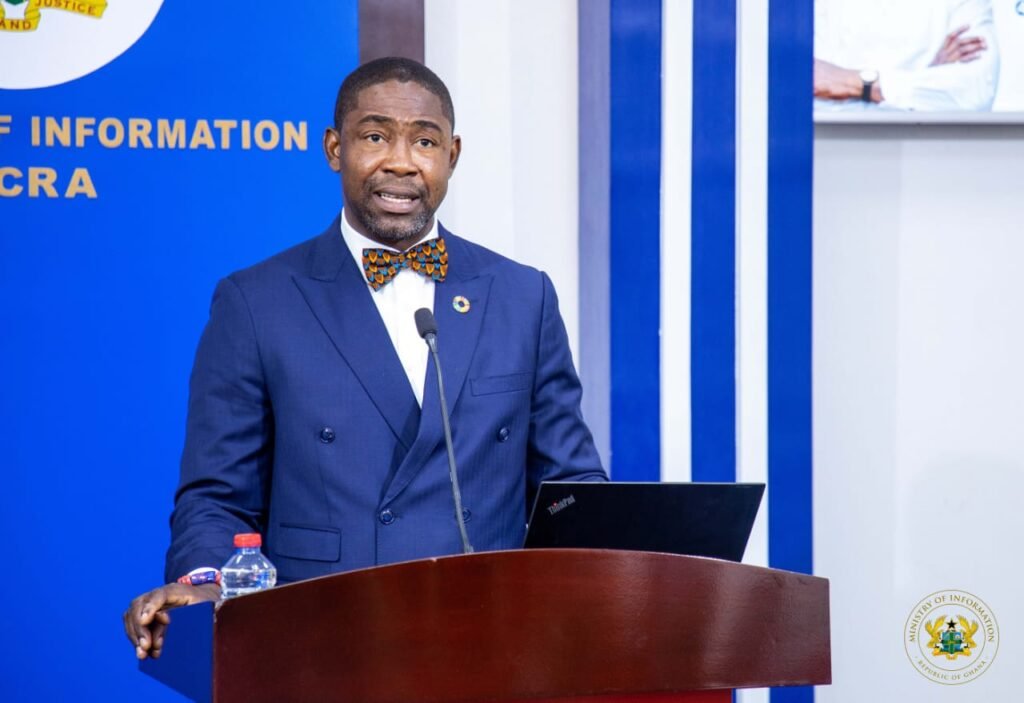
By Isabella Agyakwa
The Minister of Health, Bernard Okoe-Boye, says Ghana had made notable progress in healthcare delivery with a focus on expanding infrastructure and leveraging digital solutions, even before the ambitious Agenda 111 project was birthed.
He indicated that, for instance, the Kumawu and Fomena District hospitals, which were 30% and 35% completed, and started by the erstwhile National Democratic Congress (NDC) government, had been completed by the Nana-Addo-led administration.
Taking his turn at the Minister’s Press Briefing organised by the Information Ministry yesterday, Dr. Okoe-Boye disclosed that the government had also upgraded existing hospitals, which included the commissioning of phase two of the Bolgatanga Hospital at $20 million.
“Before, patients had to be transported to another hospital for essential diagnostic tests like CT scans. Now, Bolga has its own fully functioning CT scan, which is a significant step forward in healthcare delivery,” the Minister noted.
He also listed several ongoing projects, which included the completion of the Koforidua Eastern Regional Hospital and the 250-bed Sewua Treatment Centre in Ashanti Region.
“These investments not only improve health outcomes, but also create jobs, demonstrating the government’s commitment to both healthcare and economic development,” he said.
He explained that the country’s healthcare landscape was rapidly evolving, with the government determined to ensure every Ghanaian had access to quality medical care.
“We are working tirelessly to operationalize more facilities and bring healthcare closer to the people,” the Minister emphasised.
E-health project
Dr. Okoe-Boye further disclosed that most hospitals in Ghana were interconnected, with the deployment of advanced IT enabled systems that have streamlined patient care and enhanced data management.
“If you are transferred from Central Regional Hospital to Korle Bu Teaching Hospital, you don’t carry a folder. You just have to give your ID number, and the system has all your data,” Dr Okoe Boye explained.
He cited the National E-Health Project which serves as a real-time health surveillance system and helps medical authorities identify disease outbreaks promptly.
“In real-time, the Ministry of Health and Ghana Health Service can immediately tell that something is happening in the country, and we can move to address it promptly,” he said.
He stated that, under the current administration, hospitals had received technological upgrades, including networking infrastructure, laptops, and tablets for healthcare professionals.
He further reiterated that the digital transformation extended to the National Health Insurance Scheme (NHIS) through the My NHIS app, which allows citizens to register for health insurance using their Ghana Card and mobile payment options.
La, Weija hospitals
Giving an update on the La General Hospital and the Children’s Hospital at Weija, he said they were 19% and 60% completed, respectively.
Dr. Okoe Boye explained that the project at Weija was intended to relieve pressure on Princess Marie Louise Hospital, Accra’s only operational children’s hospital.
“We are working with speed to make sure that before the end of this year, Princess Marie Louis relocates to the new Weija Municipal Children’s Hospital,” he stated
He said that the new 120-bed Weija Children’s Hospital would modernize pediatric care in the Greater Accra Region, pointing out that while adult patients may eventually be admitted, the hospital’s primary focus would always remain on pediatric care.
“Some of the health workers in Greater Accra wanted it to be a hospital for everybody. We are not going to agree. It’s for children, and it will remain for children,” he said.
Dr. Okoe Boye also stated that despite the challenges presented by the global financial crisis and Ghana’s debt exchange programme, he was confident in the government’s capacity to complete these projects.
He emphasized the government’s resilience in advancing these important healthcare infrastructure projects, despite challenges such as financial difficulties, logistical issues, or delays. He said the government had remained committed to pushing forward with the construction and improvement of healthcare facilities.
“For those who have passed, we can’t bring them back. But for projects that have stalled, we can reactivate them,” he said.




